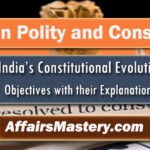Set 2 | Unlock Your Knowledge: MCQs on Making of Constitution
Unlock Your Knowledge: MCQs on Making of Constitution. Constituent Assembly and making of the Constitution plays a huge role in shaping Indian Polity and Governance, and it’s one of those things that really lays the groundwork for doing well in competitive exams—whether it’s Civil Services, State exams, SSC, Railways, Banking, or any of the others out there.
Diving deep into Indian Polity, Constitution, and governance isn’t just about memorizing facts or ticking boxes for exams, but more about developing the kind of awareness that can make navigating these challenging exams a little less overwhelming and a lot more manageable.
| MCQs on Making of Constitution – Objective Questions and Answers |

Q11. Concurrent List included in Indian Constitution is given by (Jharkhand P.C.S. (Pre) 2003)
[A] The Soviet Union
[B] Australia
[C] Italy
[D] Canada
View Explanation
Correct Answer is B.
- The idea of having a Concurrent List in India’s Constitution, where both the central and state governments can make laws on the same subjects, came from the Australian Constitution.
- Soviet Union → Inspired India’s Fundamental Duties and the idea of a Five-Year Plan.
- Canada → Borrowed the idea of a strong central government and the residuary powers with the Union.
Q12. The concept of ‘the Directive Principles of State Policy’ in the Indian Constitution has been adopted from the Constitution of – (U.P.P.C.S. (Pre) 1998)
[A] France
[B] Ireland
[C] Japan
[D] U.S.S.R.
View Explanation
Correct Answer is B.
India took the idea of Directive Principles of State Policy (DPSP) from the Irish Constitution. These principles are guidelines for the government to create policies aimed at social and economic welfare, though they are not legally enforceable.
- France → Inspired Liberty, Equality, Fraternity in the Preamble.
- Japan → Contributed to Procedure Established by Law in judiciary.
- U.S.S.R. → Gave the idea of Fundamental Duties and the Five-Year Plans.
Q13. Indian Constitution has taken a certain feature of the Constitution of other countries, which country has contributed to the framing of the ‘Directive Principles of State Policy’? (U.P. Lower Sub. (Spl.) (Pre) 2004)
[A] France
[B] Ireland
[C] Japan
[D] U.S.A.
View Explanation
Correct Answer is B.
India borrowed the idea of Directive Principles of State Policy (DPSP) from Ireland’s Constitution. These principles guide the government in making laws to promote social and economic justice, though they aren’t enforceable by courts.
- France → Inspired Liberty, Equality, Fraternity in the Preamble.
- Japan → Contributed to Procedure Established by Law in the judicial system.
- U.S.A. → Gave Fundamental Rights, Judicial Review, and the concept of Impeachment of the President.
Q14. In giving representation to talent, experience, and service in the composition of the Council of States, the Constitution makers of India were influenced by the example of – (U.P.P.C.S. (Pre) 1998)
[A] Irish Republic
[B] Canada
[C] U.S.A.
[D] Australia
View Explanation
Correct Answer is A.
India’s Rajya Sabha (Council of States) includes nominated members with expertise in fields like literature, science, art, and social service, a concept inspired by Ireland’s Seanad Éireann (Senate). This ensures representation of talent, experience, and service in governance.
- Canada → Inspired a strong central government and residuary powers with the Union.
- U.S.A. → Gave Fundamental Rights, Judicial Review, and the concept of a Senate (but with an elected system, unlike Rajya Sabha).
- Australia → Influenced Concurrent List and the concept of Cooperative Federalism.
Q15. Match List-I and List II and give correct answer by using the code given below (I.A.S. (Pre) 1993)
| Feature of Constitution of India | Source |
| A. Fundamental Right | 1. United Kingdom |
| B. Parliamentary System | 2. United States |
| C. Emergency Provisions | 3. Ireland |
| D. DPSP | 4. Germany 5. Canada |
Code:
[A] A-2 B-4 C-5 D-1
[B] A-5 B-1 C-3 D-4
[C] A-2 B-1 C-4 D-3
[D] A-1 B-2 C-4 D-3
View Explanation
Correct Answer is C.
- A. Fundamental Rights → (2) United States
- Inspired by the Bill of Rights in the U.S. Constitution.
- B. Parliamentary System → (1) United Kingdom
- India adopted the Westminster model, including a bicameral legislature, Prime Minister, and Cabinet system.
- C. Emergency Provisions → (4) Germany
- Borrowed from the Weimar Constitution of Germany, which included provisions for declaring an emergency.
- D. Directive Principles of State Policy (DPSP) → (3) Ireland
- Inspired by Ireland’s Constitution, aiming at socio-economic justice and guiding state policies
Q16. Match List-I with List-II and identify correct answer from the code given below : (R.A.S./R.T.S. (Pre) (Re. Exam) 2013)
| Constitutional Provision | Source |
| A. Fundamental Right | i. British Constitution |
| B. DPSP | ii. Canadian Constitution |
| C. Cabinet Government | iii. Irish Constitution |
| D. Union-State Relations | iv. U.S. Bill of Rights |
[A] A-iv B-iii C-ii D-i
[B] A-iv B-ii C-iii D-i
[C] A-iv B-i C-iii D-ii
[D] A-iv B-iii C-i D-ii
[E] A-i B-iii C-i D-iv
View Explanation
Correct Answer is D.
- A. Fundamental Rights → (iv) U.S. Bill of Rights
- India’s Fundamental Rights were inspired by the Bill of Rights in the U.S. Constitution.
- B. Directive Principles of State Policy (DPSP) → (iii) Irish Constitution
- India adopted DPSP from Ireland, guiding the state in promoting social and economic justice.
- C. Cabinet Government → (i) British Constitution
- The parliamentary system with a Cabinet headed by the Prime Minister was taken from the UK model.
- D. Union-State Relations → (ii) Canadian Constitution
- India borrowed the concept of a strong central government and the division of powers from Canada.
Q17. Match List-I with List-II and identify correct answer from the code given below : (U.P.P.S.C. (GIC) 2010)
| Constitutional Provision | Source |
| A. Rule of Law | 1. Australia |
| B. Procedure established by Law | 2. England |
| C. Reserving of bill by Governor for President’s consideration | 3. Japan |
| D. Concurrent List | 4. Canada |
[A] A-1 B-2 C-3 D-4
[B] A-2 B-1 C-4 D-3
[C] A-3 B-2 C-1 D-4
[D] A-2 B-3 C-4 D-1
View Explanation
Correct Answer is D.
- A. Rule of Law → (2) England
- The principle that “law applies equally to all” and no one is above the law comes from the British legal system.
- B. Procedure Established by Law → (3) Japan
- India adopted “Procedure Established by Law” from the Japanese Constitution, meaning a law is valid as long as it is enacted properly, even if it violates fundamental rights.
- C. Reserving of Bill by Governor for President’s Consideration → (4) Canada
- The provision allowing the Governor to reserve certain bills for the President’s approval was taken from Canada’s federal system.
- D. Concurrent List → (1) Australia
- The Concurrent List, where both the Union and State governments can legislate on the same subjects, was influenced by Australia’s federal structure.
Q18. Match List-I with List-II and select the correct answer: (I.A.S. (Pre) 2003)
List-I
A. Directive Principles of State Policy
B. Fundamental Rights
C. Concurrent List for Union-State Relations
D. India as a Union of States with greater powers to the Union
List-II (Country from which it was derived)
1. Australia 2. Canada
3. Ireland 4. United Kingdom
5. United States of America
[A] A-5 B-4 C-1 D-2
[B] A-3 B-5 C-2 D-1
[C] A-5 B-4 C-2 D-1
[D] A-3 B-5 C-1 D-2
View Explanation
Correct Answer is D.
- A. Directive Principles of State Policy → (3) Ireland
- Inspired by Ireland’s Constitution, DPSP serves as a guideline for the government to promote social and economic justice.
- B. Fundamental Rights → (5) United States of America
- Borrowed from the U.S. Bill of Rights, ensuring basic freedoms and protections for citizens.
- C. Concurrent List for Union-State Relations → (1) Australia
- The Concurrent List, where both the Union and States can legislate, was influenced by Australia’s federal system.
- D. India as a Union of States with Greater Powers to the Union → (2) Canada
- India’s strong central government structure and residuary powers were inspired by Canada’s federal model.
Q19. The concept of Fundamental Duties has been taken from- (U.P.U.D.A./L.D.A. (Pre) 2004)
[A] American Constitution
[B] British Constitution
[C] Russian (Former Soviet Union) Constitution
[D] French Constitution
View Explanation
Correct Answer is C.
India borrowed the idea of Fundamental Duties from the Soviet Union (USSR) Constitution. These duties were added to the Indian Constitution by the 42nd Amendment Act, 1976, based on the recommendations of the Swaran Singh Committee. They emphasize civic responsibility and include respecting the Constitution, national symbols, and promoting harmony.
- American Constitution → Inspired Fundamental Rights, Judicial Review, and the Preamble.
- British Constitution → Contributed to Parliamentary System, Rule of Law, and Cabinet Government.
- French Constitution → Inspired Liberty, Equality, Fraternity in the Preamble.
Q20. Assertion (A): The Constitution of India has become the longest one.
Reason (R) : The chapter on Fundamental Rights has been borrowed from the model of American Constitution.
Choose the correct answer using the code given below. (U.P.P.C.S. (Pre) 2015)
Code :
[A] Both (A) and (R) are true, and (R) is the correct explanation of (A).
[B] Both (A) and (R) are true, but (R) is not the correct explanation of (A).
[C] (A) is true, but (R) is false
[D] (A) is false, but (R) is true.
View Explanation
Correct Answer is B.
- India’s Constitution is the longest written Constitution in the world. When it was first made, it had 22 Parts, 395 Articles, and 8 Schedules.
- One reason it’s long is that Fundamental Rights were taken from the U.S. Constitution, but that’s not the only thing that made it lengthy. There are many other reasons too, like the detailed administrative structure, special provisions for states, and a mix of both unitary and federal systems.
- This means both the Assertion (A) and Reason (R) are correct, but (R) doesn’t fully explain (A) in the right way.
Q21. The concept of Fundamental Rights, as incorporated in the Indian Constitution has been adopted from- (U.P.R.O./A.R.O. (Pre) 2014)
[A] France
[B] Britain
[C] United States of America
[D] Russia
View Explanation
Correct Answer is C.
India’s Fundamental Rights were inspired by the U.S. Bill of Rights.
These rights are enshrined in Part III of the Indian Constitution and guarantee civil liberties and freedoms such as the Right to Equality, Right to Freedom, Right against Exploitation, Right to Freedom of Religion, Cultural & Educational Rights, and Right to Constitutional Remedies.
- France → Inspired Liberty, Equality, Fraternity in the Preamble.
- Britain → Contributed to Parliamentary System, Rule of Law, and Cabinet Government.
- Russia (Former Soviet Union) → Gave Fundamental Duties and Socialist Principles.
Q22. Among the following given names, whose portfolio in the first cabinet of India (1947) was different from his portfolio in the Interim Government (1946)? (Chhattisgarh P.C.S. (Pre) 2020)
(i) Jagjivan Ram (ii) Dr. Rajendra Prasad
(iii) C.H. Bhabha (iv) Sardar Baldev Singh
[A] Only (i) and (ii)
[B] Only (iii) and (iv)
[C] Only (i) and (iii)
[D] Only (iii)
View Explanation
Correct Answer is D.
Portfolios in the Interim Government (1946):
- Dr. Rajendra Prasad → Food and Agriculture
- Jagjivan Ram → Labour
- Sardar Baldev Singh → Defence
- C.H. Bhabha → Works, Mines, and Power
Portfolios in the First Cabinet of Independent India (1947):
- Dr. Rajendra Prasad → Food and Agriculture
- Jagjivan Ram → Labour
- Sardar Baldev Singh → Defence
- C.H. Bhabha → Commerce
C.H. Bhabha (Changed from Works, Mines, and Power → Commerce)



